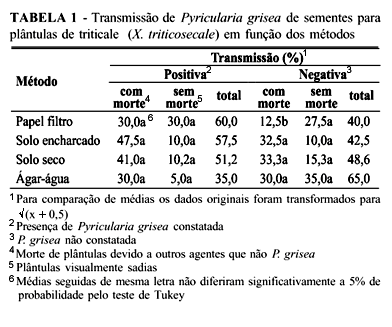Triticale (X. triticosecale) is the most recent host of Magnaporthe grisea (Pyricularia grisea), the causal agent of blast, in São Paulo state. Severe yield losses occurred in large areas in the southern part of the state in 2001. It is speculated that seed borne infection played a vital role in the outbreak and dissemination of this disease. Nevertheless, transmission of disease from seeds to seedlings is still a matter of controversy, in both rice (Oryza sativa) blast and wheat (Triticum aestivum) blast. One reason for this debate may be associated with the method used in those studies. The present work was designed to examine the seed borne transmission of P. grisea from seeds to seedlings in triticale under different methods using 100% infected seeds and controlled temperature of 21 °C and 12 h cycles of light. The treatments were as followed: a) seeding in sterilized soil; b) moist but not flooded seeding in sterilized soil; c) seeding in water-agar media; d) seeding in filter paper. The treatments were arranged in a randomized block design with four replications. Transmission of P. grisea from seeds to seedlings was found in all methods with two types of symptoms: death of seedlings and symptoms on leaves with no death. The rate of transmission of these symptoms was similar in all methods, suggesting that any of these methods could be used. Healthy seedlings with no visible blast symptoms emerged from infected seeds in all methods.
Comunicação • Fitopatol. bras. 29
(4)
• Aug 2004 • https://doi.org/10.1590/S0100-41582004000400011 copy

 Methods to examine transmission of Pyricularia grisea from seeds to seedlings of triticale
Methods to examine transmission of Pyricularia grisea from seeds to seedlings of triticale